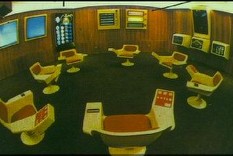Wow — teletype machines and cybernetics to run an economy!
Before ’73 Coup, Chile Tried to Find the Right Software for Socialism – New York Times
(note they mean this version of the word “cybernetics”)
And here’s a better Guardian article on it.

I suspect this happens anyway today — using computers to help decisionmakers run the economy — but without the cool Star Trek chairs and display screens. Economists at central banks get data and use computers to analyze it, then eventually the data is used to inform decisions.
Though this vision involves more fine-grained data collection and automated analysis. (And other more Internet-y things like two-way communication between workers and management/government.). I suspect it would be way easier to do today, with better computational infrastructure (CPU, memory, data transmission, and software are better these days).
This happened all over the Eastern block, only without the funny chairs: teletype terminals in factories used for production reporting, “computer centers” in each city (even mine, which had about 8000 people, had it’s own mainframe running a factory), relatively affordable microcomputers (prices from about 3 month worth of minimum salary for the cheapest one, to more expensive devices that came with their own displays and tape reader) during the ’80s (a pity most adults thought that those were gaming devices as opposed to the big clunky machines that were fed cardboard cards), most high schools had their own computer lab with 10 to 30 microcomputers and at least one hour per week scheduled for “Informatics” if not an entire “Math-Info” section where there were at least 6 hours per week for the subject. I have personally met an old accountant that that used Fortran in the central planning office and one military guy trained as engineer who used Fortran at work, and both started working with that in the early ’70s.
Of course, quite all of that went bust in the early ’90s. In 1990 or 1991 the company that made the mainframes attempted to launch a personal computer (I don’t think it was IBM compatible, but it had pretty good graphic capabilities) and marketed it for business purposes and for design, but it did not last because quite soon after the liberalization nobody had the funds or the motivation to buy them… by 1993 I was looking for a way to salvage the blank cards used in the factory’s computer in order to use it for bibliographical notes, but either somebody got there first, or they just threw the boxes away. .. I am not even sure what was the bloody machine used for, since they shut it down it soon after 1990 but the factory continued to produce for a few more years after that.
Economy was not “run by computers”, but accounting and planning certainly used them to the full.
I don’t know much about how those computers were networked at that time (I was 14 in 1989), but in December 1989 it was used to coordinate the action of county officials … not that it helped much, since the fall of Communism was an inside job anyway :P …
What a story. Thanks for sharing.
Now I wonder whether Western corporatins used networked teletype machines to report from factories to headquarters…
“Now I wonder whether Western corporatins used networked teletype machines to report from factories to headquarters…”
I am not certain that would have been necessary or even recommended. What was attempted in the East was to optimize the production to the maximum … and of course it did not work perfectly, since rewards being conditioned on fulfilling the plan, everybody was tempted to cheat a bit, and some even more than a bit. The system was designed to work pretty much on a “just-in-time” basis, and everybody depended on everybody, and if somebody overreported or underreported his production or consumption, and that happened a lot even if most of the time just by a small amount, the flow suffered.
Kind of funny, if you enjoy dark humor, is that in my country in 1990 planning stopped and some sort of “workers democracy” was introduced based on the “one employee, one vote” rule. What happened first was that the unpopular managers were fired (and those were almost all the experienced managers) and more popular guys or gals were elected. The second was that the most of the “Auxiliary Technical Personnel” (meaning “not working on the assembly line”) fellows were fired too, including all the “Technical Quality Control” people, so only “productive” personnel was kept. The result was that in three years chaos replaced strict planning and control. Had there been less vertical integration, maybe it would have had evolved differently, but as it was, even privatization was not really an option: with the whole supply chain in chaos, not many single units were worth the effort of saving.
The smartest way, like the Poles, the Czechs or the Hungarians did, was to let it hit the bottom, see what survives, and start again from there. Yugoslavia is a special case, but Rumania, Bulgaria and most of the former Soviet Union successor states attempted to control the downward spiral and it took about seven years to get to the bottom of it … and maybe there was no real choice, since there was no bailout in sight, all that happened live and not in a computer model, and people still had to survive until the industries that adjusted faster and began growing compensated for those that were going under.
“What a story. Thanks for sharing.”
apologies for turning your blog into a one-man “Ostalgics Anonymous” meeting … the Chile story brought it all back.